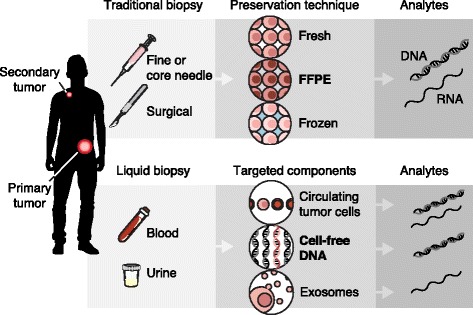Fig. 1.

Overview of the most commonly used biopsy techniques, preservation methods, and genomic analytes. Traditional biopsy methods include fine- or core-needle biopsy or surgical resection. These biopsies typically only access the primary tumor site. From traditional tissue biopsy the most common pathological preservation path is through formalin fixation and paraffin embedding (FFPE), though fresh frozen tissue or disaggregated cells are sometimes also available. From each of these material types, both DNA and RNA can be extracted. Liquid biopsy usually involves blood draw, though some groups are now testing urine and other body fluids. Liquid biopsy can have representative somatic lesions from more than one tumor site. Circulating tumor cells (CTCs), cell-free DNA (cfDNA), and exosomes or extracellular vesicles (EVs) are the most common components of liquid biopsy that are isolated for somatic analysis. DNA and RNA can be isolated from CTCs, but only DNA is represented in the cfDNA extraction, and RNA is most commonly targeted from EVs
